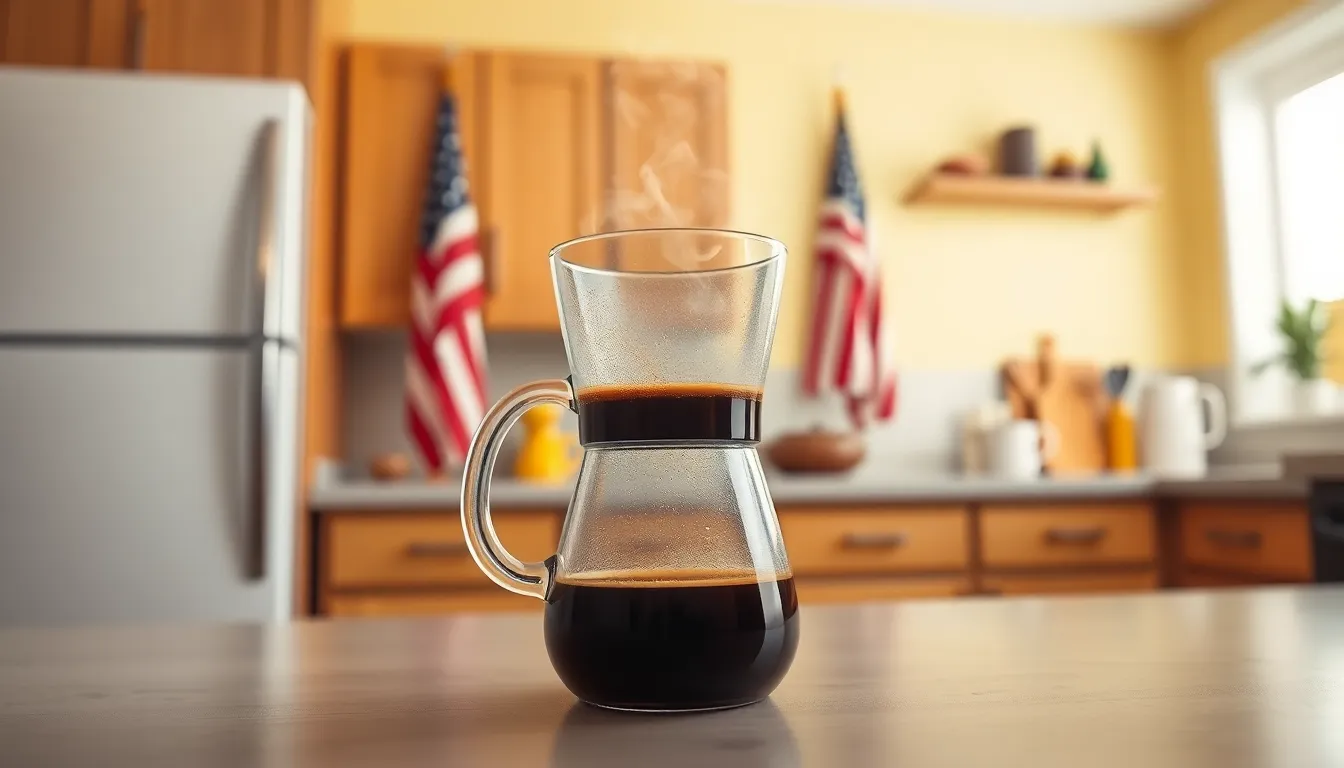Can you put hot coffee in the fridge? It’s a common question many coffee lovers face when they’ve brewed too much or need to cool down their beverage quickly. Whether you’re trying to make iced coffee or simply save leftovers for later, understanding the right way to cool your coffee matters.
You might be concerned about food safety, glass containers cracking, or even affecting other foods in your refrigerator. The good news is that storing hot coffee properly isn’t complicated once you know the facts. In this text, we’ll explore the best practices for refrigerating coffee and address the common myths that might have left you confused about this everyday kitchen dilemma.
The Hot Coffee Dilemma: Is Refrigeration Safe?
Putting hot coffee directly in your refrigerator raises several safety concerns that many coffee drinkers overlook. Extreme temperature changes can potentially damage both your refrigerator and the container holding your coffee. Glass containers are particularly vulnerable to thermal shock, which occurs when the material rapidly contracts due to the sudden temperature drop, potentially causing cracks or breakage.
Food safety experts at the USDA recommend cooling hot foods to room temperature within 2 hours before refrigeration to prevent bacterial growth. Hot liquids like coffee can create a warm, humid environment inside your refrigerator, potentially raising the internal temperature above the safe food storage threshold of 40°F (4°C). This temperature increase affects not just your coffee but all surrounding foods.
“I’ve learned this lesson the hard way,” shares Rikki Manny. “After placing freshly brewed coffee straight into my fridge, I noticed condensation building up on nearby containers and even had a glass carafe crack from the thermal shock.”
Your refrigerator’s compressor works harder when hot items are introduced, potentially reducing its efficiency and lifespan. The extra energy required to cool hot liquids contributes to higher electricity bills and unnecessary wear on your appliance. Also, the steam released from hot coffee can lead to excessive moisture inside your refrigerator, creating conditions where mold and bacteria thrive.
Coffee quality suffers from improper cooling methods too. The flavor compounds in coffee oxidize more rapidly at higher temperatures, leading to bitter notes developing during the extended cooling process. Coffee experts recommend cooling your brew to room temperature first to preserve its original flavor profile and aromatic compounds.
Understanding Food Safety Concerns

Refrigerating hot coffee requires careful consideration of several food safety factors. While coffee itself isn’t typically a breeding ground for bacteria, the way you store it can affect both your beverage and other items in your refrigerator.
Bacterial Growth in the Danger Zone
Bacteria multiply rapidly in temperatures between 40°F and 140°F, an area food safety experts call the “danger zone.” Placing very hot coffee directly into your refrigerator can temporarily raise the internal temperature, potentially pushing surrounding foods into this danger zone. This temperature fluctuation creates ideal conditions for harmful bacterial growth in perishable items. For safer storage, let your coffee cool at room temperature for 15-20 minutes before refrigerating, or transfer it to a heat-safe container that promotes faster cooling without significantly warming your fridge.
Impact on Other Foods in Your Refrigerator
Hot containers in your refrigerator can increase the overall temperature, putting sensitive foods at risk. Dairy products like milk, butter, and cheese are particularly vulnerable to temperature fluctuations and may spoil faster when exposed to heat. To protect your groceries when storing hot coffee, position the container away from temperature-sensitive items and leave space around it for proper air circulation. This simple arrangement helps minimize heat transfer to neighboring foods and maintains the refrigerator’s safe temperature range. Using airtight stainless steel or glass containers rather than plastic also helps preserve coffee flavor while preventing odor exchange between your coffee and other refrigerated items.
The Science Behind Cooling Coffee
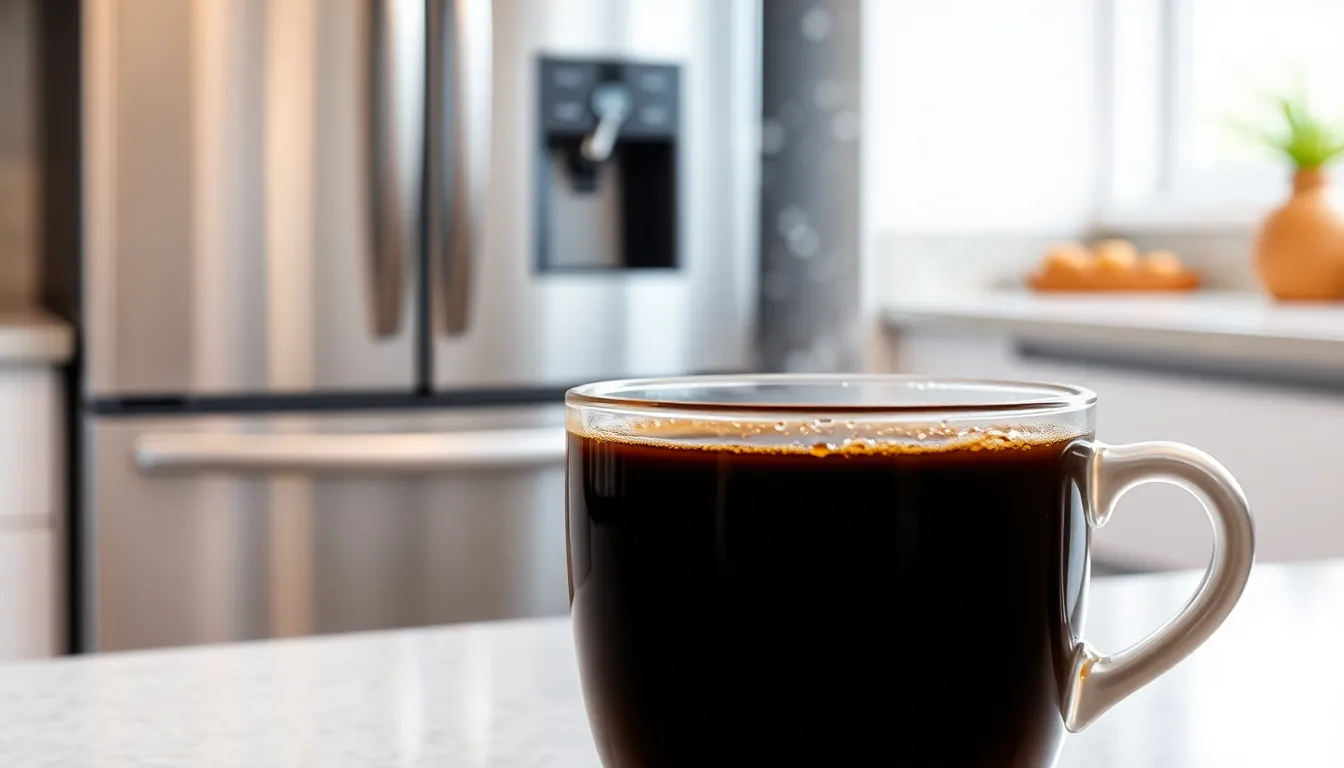
Coffee cooling involves complex chemical and physical processes that affect both your beverage and refrigerator. Understanding these scientific principles helps explain why proper cooling methods matter for preserving flavor and maintaining appliance efficiency.
Flavor and Chemical Changes
Coffee contains natural oils and acids that break down through oxidation after brewing. Refrigeration slows this oxidation process compared to leaving coffee at room temperature, which can extend your coffee’s drinkable lifespan. Cold temperatures don’t completely halt deterioration, though – coffee can still develop stale or bitter flavors if not stored properly in the refrigerator. Your coffee becomes particularly vulnerable to absorbing odors from other foods when not sealed in an airtight container, further compromising its delicate flavor profile.
Heat Transfer and Condensation
Hot coffee releases thermal energy into your refrigerator through convection and radiation. This energy transfer occurs as heat naturally moves from warmer objects (your coffee) to cooler surroundings (the refrigerator interior). The temperature difference creates condensation on both the coffee container and nearby surfaces as warm air meets cold surfaces. Moisture from this condensation can eventually dilute your coffee, resulting in a watered-down taste. Temperature fluctuations from repeatedly moving coffee in and out of the fridge promote additional odor absorption, further altering the original flavor characteristics of your brew.
Effect on Refrigerator Temperature
Placing hot coffee directly in your refrigerator triggers an immediate increase in internal air temperature. This temperature spike forces your refrigerator’s compressor to work harder as it attempts to restore the set cold temperature. The cooling system must expel extra heat energy, consuming more electricity and potentially creating temperature inconsistencies throughout the refrigerator compartment. Other perishable items stored nearby may experience temporary warming, which can compromise food safety if temperatures rise above 40°F for extended periods. Frequent introduction of hot items accelerates wear on refrigeration components by forcing more cooling cycles than normal operation requires.
For optimal results, let your coffee cool slightly at room temperature before refrigerating it in a heat-safe, airtight container. This approach protects both your coffee’s flavor profile and your refrigerator’s efficiency while preventing unnecessary energy consumption.
Proper Methods for Cooling Coffee
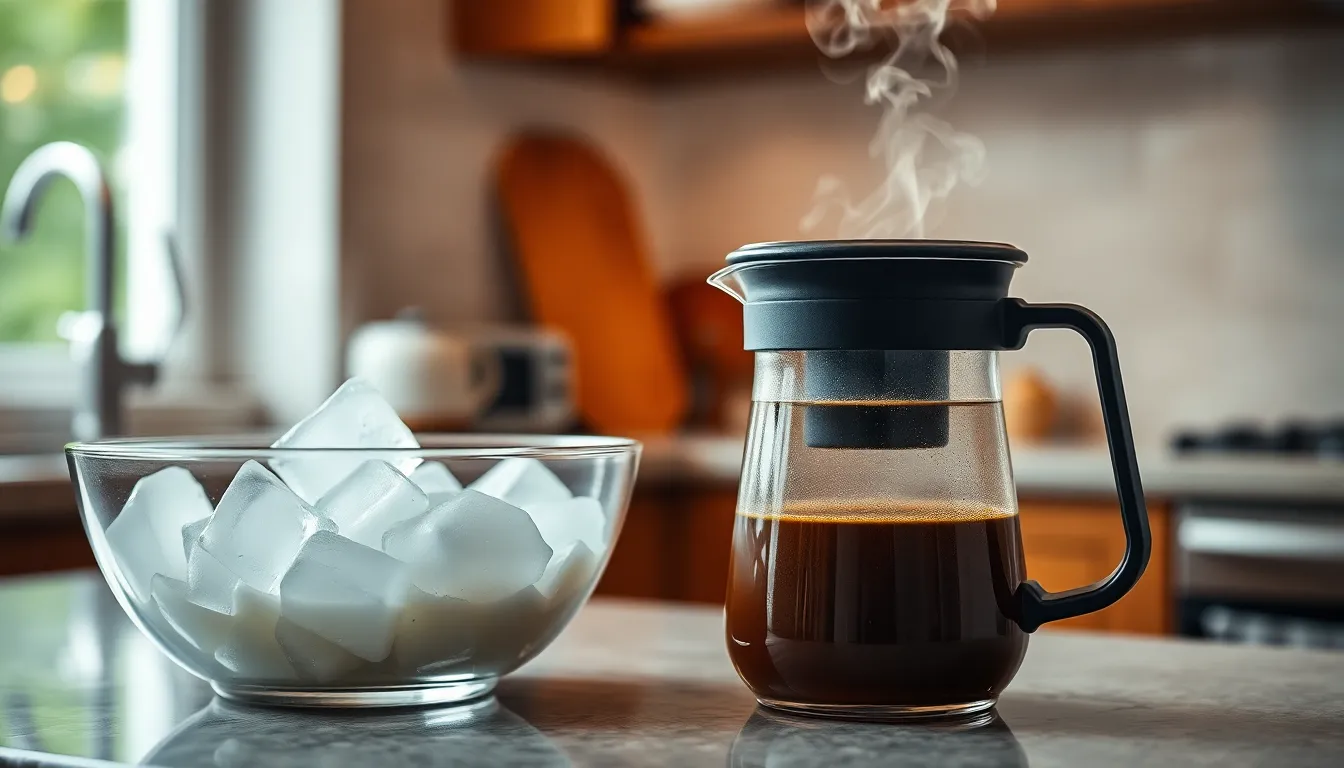
Cooling your coffee properly before refrigeration preserves its flavor and ensures food safety. Research shows that the method you choose impacts both the quality of your coffee and the efficiency of your refrigerator.
The Room Temperature Approach
Allowing hot coffee to cool naturally at room temperature requires minimal effort while maintaining flavor integrity. This method works best when you’re not in a hurry, as coffee should reach approximately 68–72°F (20–22°C) before refrigeration. Letting your coffee sit on the counter for 15-20 minutes prevents thermal shock to both your container and refrigerator. This natural cooling process also minimizes undesirable changes in coffee flavor and aroma that occur with rapid temperature fluctuations. Simply place your coffee in a heat-resistant container and let it rest uncovered until it no longer feels hot to the touch.
Using Ice Baths for Rapid Cooling
Ice baths provide a significantly faster cooling method when you need to refrigerate coffee quickly. Place your coffee container (preferably metal or another heat-conductive material) into a larger bowl filled with ice and some water. The cooling effect transfers directly through the container walls, rapidly lowering the coffee’s temperature while preserving its flavor profile. Stirring the coffee occasionally during this process ensures even cooling throughout the liquid. This method typically reduces cooling time to just 5-10 minutes, minimizing the time your coffee spends in the bacterial danger zone. Metal containers work particularly well with this technique due to their superior heat conductivity compared to glass or plastic alternatives.
Best Practices for Storing Coffee
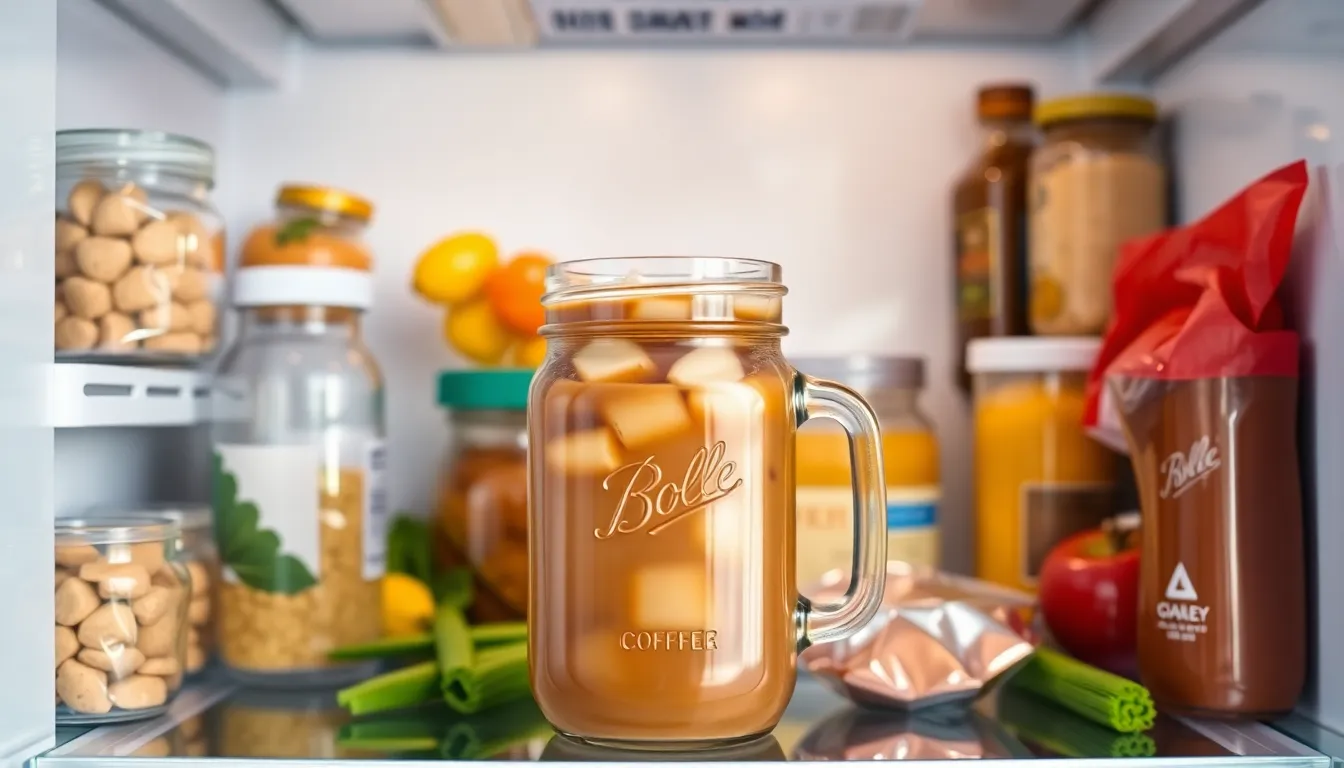
Proper coffee storage techniques preserve flavor and extend freshness, making your refrigerated brew more enjoyable days after preparation. Following these guidelines ensures optimal taste while maintaining food safety standards in your refrigerator.
Container Options for Refrigerated Coffee
Selecting the right container significantly impacts coffee flavor retention during refrigeration. Stainless steel containers with tight-fitting lids offer superior protection by preventing odor absorption and maintaining temperature consistency. Glass containers like mason jars provide excellent alternatives that don’t impart unwanted flavors to your coffee. Avoid plastic containers completely as they absorb coffee oils and surrounding refrigerator odors, potentially ruining your brew’s flavor profile.
Airtight seals are essential regardless of container material, as they prevent moisture from diluting your coffee and block odor transfer between foods. Store coffee containers away from strongly aromatic foods like onions or garlic to prevent flavor contamination. Position refrigerated coffee on middle or upper shelves rather than in the door where temperature fluctuations occur more frequently.
How Long Coffee Stays Fresh in the Fridge
Properly stored black coffee remains safe to drink for up to 4 days when kept in a sealed container in the refrigerator. Coffee’s flavor compounds degrade progressively during storage, with noticeable quality decline occurring after the second day. The aromatic oils that give coffee its distinctive character oxidize during refrigeration, resulting in increasingly flat-tasting brew over time.
Coffee containing milk or cream requires stricter handling, as dairy products introduce perishability concerns. These coffee drinks should never remain at room temperature longer than 2 hours due to bacterial growth risks. Refrigerated coffee with dairy additives typically maintains acceptable quality for 1-2 days before flavor deterioration becomes pronounced. Date your coffee containers when refrigerating them to track freshness and prevent consuming stale brews.
Alternatives to Refrigerating Hot Coffee
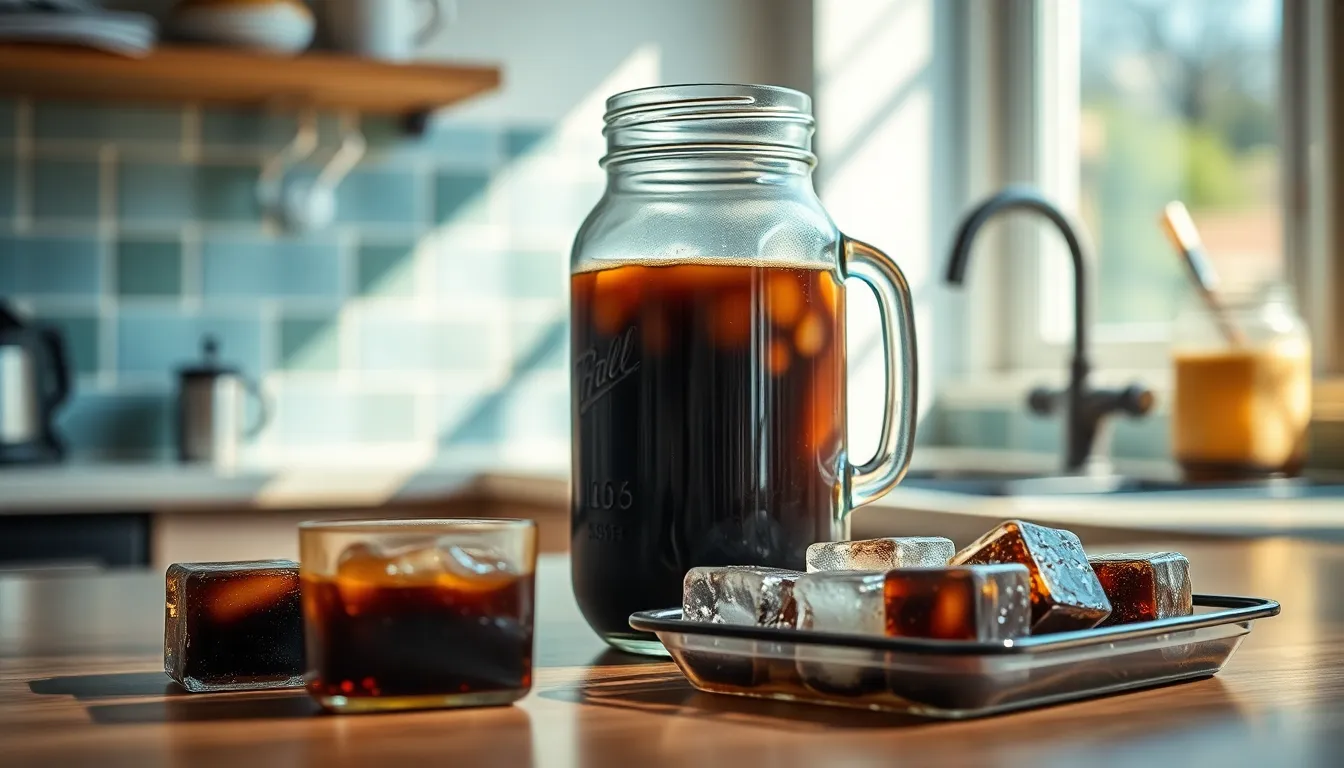
Instead of placing hot coffee directly in the refrigerator, several better alternatives preserve flavor while providing a cold coffee experience. These methods avoid the risks associated with refrigerating hot coffee and result in better-tasting cold coffee beverages.
Cold Brew: A Better Option for Cold Coffee
Cold brew coffee offers a superior alternative to refrigerated hot coffee, delivering exceptional flavor without the risks of deterioration. This method involves steeping coffee grounds in cold water for an extended period, typically 12-24 hours, creating a naturally cold coffee concentrate. Cold brew provides a smoother flavor profile with significantly less acidity than refrigerated hot coffee. The reduced acidity makes cold brew gentler on sensitive stomachs while highlighting coffee’s natural sweetness. Unlike hot-brewed coffee that’s been refrigerated, cold brew maintains its flavor integrity over several days when stored properly in an airtight container.
Making Coffee Ice Cubes
Coffee ice cubes represent an ingenious solution for preserving leftover coffee while improving future cold coffee drinks. Simply pour room-temperature coffee into ice cube trays and freeze until solid. These frozen coffee cubes chill iced coffee drinks without the watery dilution that regular ice causes. Coffee cubes maintain the beverage’s flavor intensity while gradually melting and blending with the drink. Try adding these cubes to cold milk for an effortless iced latte or use them in smoothies for a coffee flavor boost. The versatility of coffee ice cubes extends beyond beverages—they can be blended into coffee-flavored desserts or melted as needed for recipes calling for small amounts of coffee.
Conclusion
Cooling hot coffee properly before refrigeration safeguards both your beverage quality and your appliance. Taking those extra 15-20 minutes for room temperature cooling prevents potential damage to glassware prevents bacterial growth and protects other foods in your refrigerator.
For the best results store your cooled coffee in airtight glass or stainless steel containers away from strong-smelling foods. Remember that black coffee stays fresh for up to 4 days while coffee with dairy products should be consumed within 1-2 days.
Consider alternatives like cold brew or coffee ice cubes for a more flavorful cold coffee experience. These methods not only preserve the delicate flavor compounds but also give you convenient ready-to-drink options that don’t risk compromising your refrigerator’s efficiency or your food safety.
Frequently Asked Questions
Is it safe to put hot coffee in the fridge?
It’s generally not recommended to put hot coffee directly in the fridge. This practice can cause thermal shock to glass containers, raise the internal temperature of your refrigerator above safe food storage levels (40°F/4°C), and strain your appliance’s cooling system. For safety and to preserve quality, allow coffee to cool at room temperature for 15-20 minutes before refrigerating in a heat-safe, airtight container.
How long can I leave coffee at room temperature before refrigerating?
Coffee should not sit at room temperature for more than 2 hours according to food safety guidelines. This timeframe helps prevent bacterial growth in the “danger zone” (40°F-140°F). For coffee with milk or cream, the time is even shorter—refrigerate within 1 hour to maintain safety. Always transfer cooled coffee to clean containers before refrigerating.
What containers are best for storing coffee in the refrigerator?
Airtight glass or stainless steel containers are ideal for refrigerating coffee. These materials don’t absorb coffee oils or impart unwanted flavors. Avoid plastic containers, which can absorb odors and alter taste. Make sure your container has a tight seal to prevent your coffee from absorbing refrigerator odors and to maintain freshness longer.
How long does coffee stay fresh in the fridge?
Properly stored black coffee can stay safe to drink for up to 4 days in the refrigerator, though flavor quality begins declining after the second day. Coffee with milk or cream should be consumed within 1-2 days. Always check for any off smells or unusual appearance before consuming refrigerated coffee. Label containers with dates to track freshness.
Does refrigerating coffee affect its flavor?
Yes, refrigeration affects coffee flavor. Rapid cooling can increase bitterness due to oxidation, while refrigeration itself can lead to stale flavors over time. Cold brew is a better option for cold coffee as it’s specifically designed to be served cold with a smoother profile. If refrigerating hot coffee, cool it slightly first and store in airtight containers to minimize flavor deterioration.
Can refrigerating hot coffee damage my refrigerator?
Placing hot coffee directly in the refrigerator can strain its cooling system by forcing the compressor to work harder, potentially leading to increased energy consumption and shortened appliance lifespan. The heat can also temporarily raise the internal temperature above safe levels for surrounding foods. Allow coffee to cool before refrigerating to protect your appliance.
What alternatives are there to refrigerating hot coffee?
Cold brew coffee is an excellent alternative, made by steeping grounds in cold water for 12-24 hours, resulting in a smoother, less acidic beverage. Coffee ice cubes are another option—freeze leftover coffee in ice cube trays to use in iced coffee without dilution. These methods preserve flavor better than refrigerating hot coffee and provide superior cold coffee experiences.
Can I put hot coffee with milk in the fridge?
Coffee with milk requires extra caution. Allow it to cool for no more than 1 hour at room temperature before refrigerating to prevent bacterial growth. Use clean, airtight containers and consume within 1-2 days. Always check for signs of spoilage before drinking, as dairy products are more prone to bacterial contamination than black coffee.

